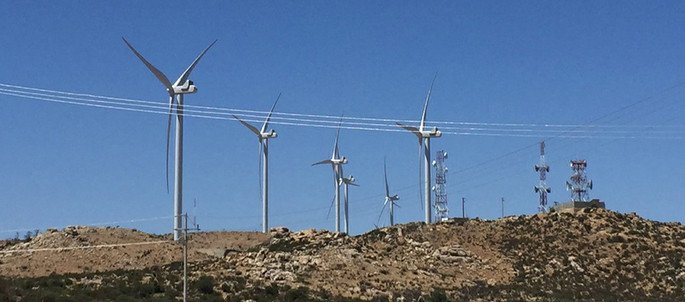First U.S.-Mexico cross-border wind farm inaugurated in Tecate, Baja California

- 155.1 MW of generation capacity
- The electricity produced is being purchased by San Diego Gas & Electric
- North American Development Bank provided a US$39 million loan to finance part of the project
The project sponsors, InterGen e Infraestructura Energética Nova, S.A.B. de C.V. (IENova) and executives from San Diego Gas & Electric (SDG&E), the North American Development Bank (NADB) and the Border Environment Cooperation Commission (BECC), among others, celebrated the completion of the project known as Energía Sierra Juárez 1, which has an installed generation capacity of 155.1 MW and began commercial operations this past June.
The electricity generated by the wind farm is being purchased by SDG&E, a subsidiary of Sempra Energy that provides service to more than 2.25 million electricity and natural gas customers in San Diego and Orange counties.
Project financing was provided by a syndicate of banks with Mizuho Bank as coordinating lead arranger, NADB as technical and modelling bank, and Nacional Financiera, Institución de Banca de Desarrollo (NAFIN), Norddeutsche Landesbank Girozentrale (NordLB) and Sumitomo Mitsui Banking Corporation (SMBC) as lenders.
Constructed on approximately 5,300 hectares (13,100 acres) of leased land near the city of Tecate, Baja California, the project consisted of designing, building and operating a wind farm with 47 wind turbines, each with a nominal capacity of 3.3. MW, as well as the construction of a 7.7 km (4.8 mile) transboundary, transmission line.
“This first cross-border wind project is a model of collaboration between the two countries,” stated NADB Managing Director Gerónimo Gutiérrez. “We are very pleased to have been a part of its implementation, and we believe that it will be first of many binational energy projects in benefit of the residents on our shared border.”
The environmental benefits related to this project include the displacement of more than 125,809 metric tons a year of carbon dioxide (CO2) and 189 metric tons a year of nitrogen oxides (NOx). The project is expected to generate electricity equivalent to the annual consumption of 70,832 households.